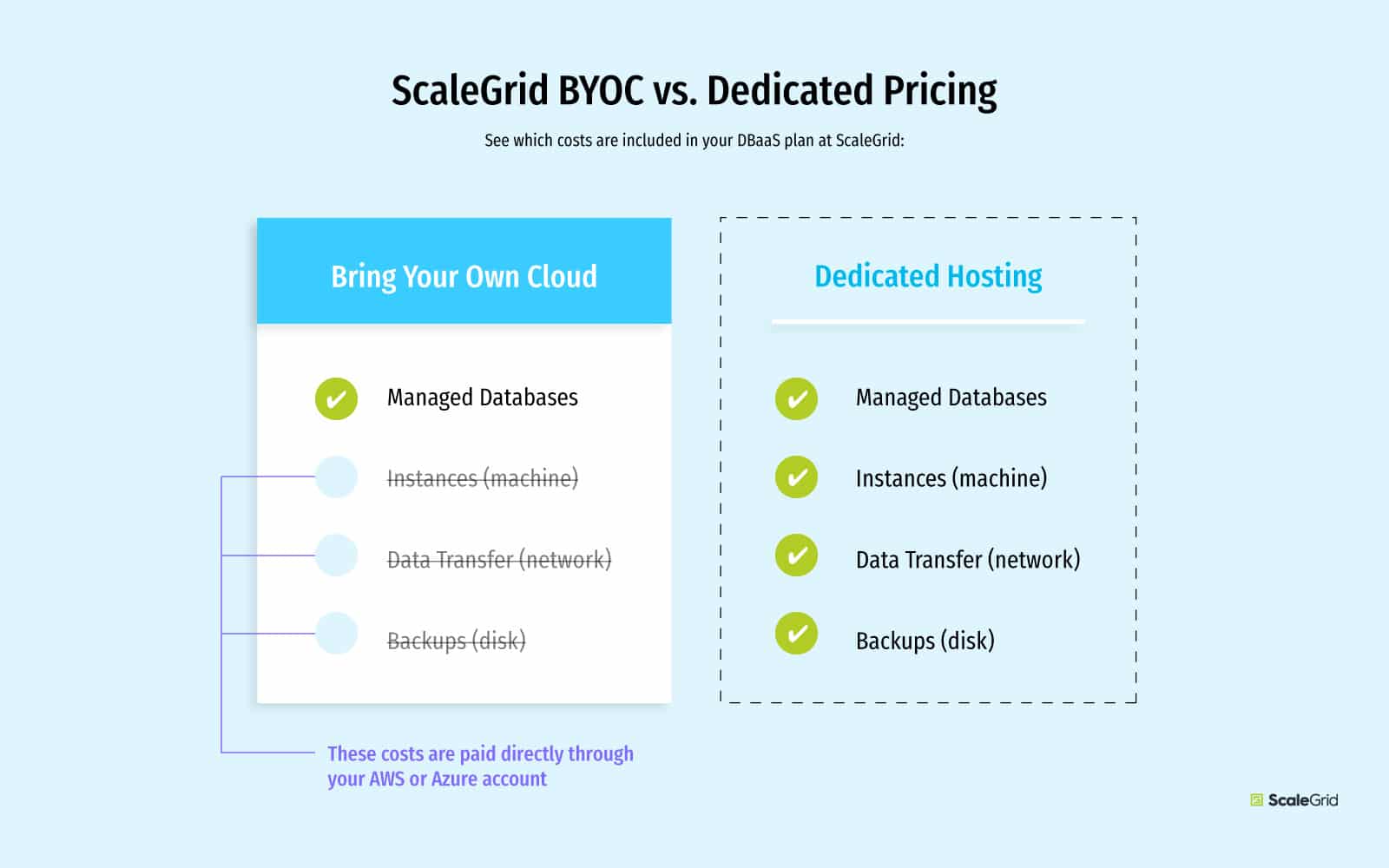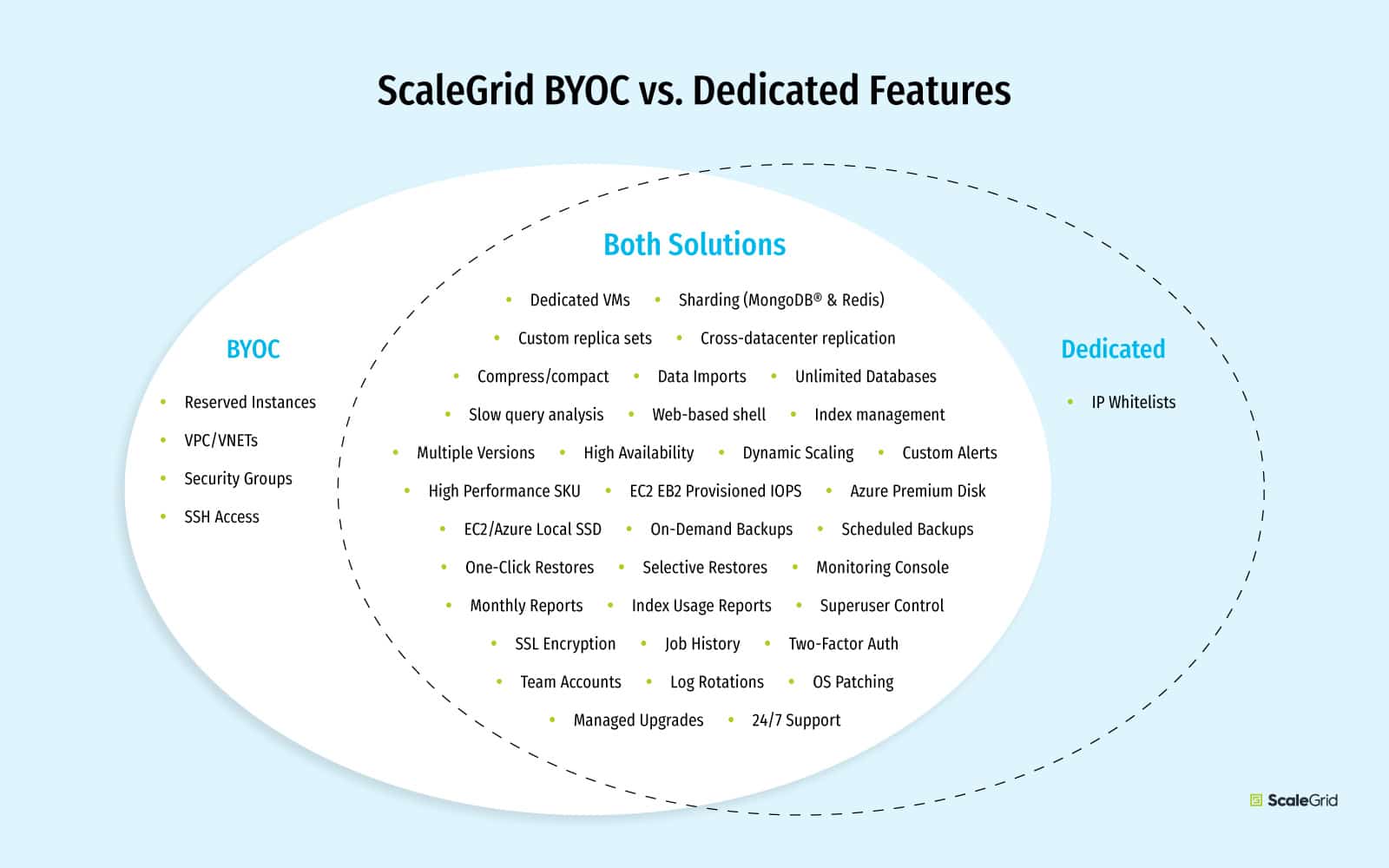Where you decide to host your cloud databases is a huge decision. You have to choose your hosting model, a cloud provider, and then your primary and standby regions to deploy to. But, if you’re considering leveraging a managed databases provider, you have another decision to make – are you able to host in your own cloud account or are you required to host through your managed service provider? In this post, we compare ScaleGrid’s Bring Your Own Cloud (BYOC) plan vs. the standard Dedicated Hosting model to help you determine the best strategy for your MySQL™, PostgreSQL®, Redis® and MongoDB® database deployment.
What is ScaleGrid’s Bring Your Own Cloud Plan?
At ScaleGrid, we offer a unique model called the Bring Your Own Cloud (BYOC) plan which allows you to actually host your database clusters through your own cloud account. This is different from the standard Dedicated Hosting model that requires you to host through your DBaaS provider. While the Dedicated model is still very popular and extremely easy to set up, many companies are adverse to using a DBaaS at all because they do not want to host through an account that is not owned by their organization.
At ScaleGrid, we support both models so our users have the choice between hosting through us or hosting in their own account. Each of these models is suitable for production deployments and high traffic applications, and are available for all of our supported databases, including MySQL™, PostgreSQL®, Redis®, and MongoDB® Hosting (Greenplum Database® coming soon). Here are the databases and cloud providers supported through each model:
| Supported Databases | Bring Your Own Cloud | Dedicated Hosting |
|---|---|---|
| MySQL | AWS, Azure, GCP, OCI, DigitalOcean | AWS, Azure, GCP, DigitalOcean, Linode, OCI |
| PostgreSQL | AWS, Azure, GCP, OCI, DigitalOcean | AWS, Azure, GCP, DigitalOcean, Linode, OCI |
| Redis™ | AWS, Azure, GCP, OCI, DigitalOcean | AWS, Azure, GCP, DigitalOcean, Linode, OCI |
| MongoDB® Database | OCI, DigitalOcean | DigitalOcean, Linode, OCI |
| Greenplum® (coming soon) | AWS | AWS |
Is the BYOC model right for my deployment?
If you can answer yes to any of these questions, BYOC is the plan for you:
- Do you want to leverage Reserved Instances to lower your long-term hosting costs up to 40%? Read now
- Are you a startup that has free cloud provider hosting credits you’d like to use for your database hosting? Read now
- Are you comfortable setting up your own cloud infrastructure through your own cloud provider account?
- Do you want to deploy in a Virtual Private Cloud/Network (VPC and VNET)? Read now
- Do you want to leverage Security Groups for access control? Read now
- Do you require SSH access to the underlying machine? Read now
BYOC vs. Dedicated Hosting Pricing
What’s the main difference between Bring Your Own Cloud pricing and our Dedicated Hosting plans? Since our BYOC plans are hosted through your own AWS or Azure account, all cloud instances, backups and data transfer costs are paid directly through your cloud provider. In contrast, ScaleGrid Dedicated hosting is all-inclusive, so you pay one fixed cost monthly (based on usage) through your ScaleGrid account. This is why our BYOC pricing is less than our Dedicated Hosting pricing, as the costs listed for BYOC are only what you pay for ScaleGrid and don’t include your hardware costs.
All DBaaS management, monitoring, and maintenance tools are included in both plans.
How much will I pay to my cloud provider through the BYOC model?
The best way to estimate the costs you will pay to AWS or Azure through our BYOC model is to find the difference between the equivalent plan size through our Dedicated Hosting model. Our Dedicated plans use on-demand instances, so as long as you’re leveraging these through your BYOC deployment, your costs should be relatively the same. Let’s walk through an example:
| Database: | MySQL |
| Cloud Provider: | AWS |
| Replication Type: | Master-Slave-Slave |
With the above cluster configurations, we can review pricing for both the Dedicated plan and BYOC plan to estimate the costs we’ll pay through our cloud provider:
| ScaleGrid Dedicated Pricing: | $560/month |
| ScaleGrid BYOC Pricing: | $232/month |
| Estimated Cloud Costs: | $328/month |
While this is a good way to get a rough estimate, your monthly cloud costs will indeed vary based on the amount of backups performed and your data transfer activity.
Reserved Instances
One of the great advantages of the BYOC model is that you can leverage Reserved Instances to lower your long-term hosting costs by up to 40%. Reserved Instances are pre-paid instances you can purchase through your cloud provider, allowing you to receive a discounted hourly rate for purchasing either 1-year or 3-years in advance. Both AWS EC2 instances and Azure VM instances are available as Reserved Instances and can be used through the BYOC plan.
Startup Hosting Credits
Additionally, the BYOC plan is also highly popular with startup companies. This is because they can leverage free AWS or Azure startup hosting credits secured through their incubator, accelerator, or startup community program, and can apply their free credits to their database hosting costs as ScaleGrid. We also offer additional savings for early-stage companies through our Startup Program, where eligible companies can get 50% off our BYOC or Dedicated plans for up to 12 months.
BYOC vs. Dedicated Hosting Features
As mentioned above, both the BYOC and Dedicated plans are fully managed and great for production deployments. A vast majority of the features are the same, outside of these advanced features available through the BYOC model:
Virtual Private Clouds / Virtual Networks
Amazon Virtual Private Clouds (VPC) and Azure Virtual Networks (VNET) are private, isolated sections of the cloud infrastructure where you can launch resources. These are advanced cloud configurations that allow you to protect your databases from the internet. VPCs and VNETs are able to be provisioned into subnets, or pieces, allowing you to segregate your workloads and control the routes between your subnets. You can also geographically distribute your clusters across availability zones to ensure high availability for your deployment. At ScaleGrid we recommend you deploy your clusters on private VPC subnets so that your database is not routable from the internet.
Deploying your application and database on the same VPC also provides the lowest possible latency path. This becomes really important for cache solutions like Redis™. It also allows you to reduce costs as you don’t have to pay for the traffic between the application and database when they are in the same VPC. This can result in significant cost savings for high traffic applications.
These powerful security configurations require an understanding of your cloud infrastructure to set up. Check out the How to Get Started section below to learn how to set up a VPC or VNET infrastructure for your deployment at ScaleGrid.
Security Groups
AWS Security Groups and Azure Network Security Groups allow you to lock down access to your servers through advanced virtual firewalls. When you set up a new database instance at ScaleGrid through the BYOC model, you’ll use Security Groups to control inbound and outbound traffic to your instances. These should be created in the same VPC or VNET as your cluster.
SSH Access to Machine
Another highly unique feature available in ScaleGrid’s BYOC plan is the ability to maintain full SSH access to the underlying machines of your deployment. This allows you to leverage external plugins and tools to better support your deployment and improve performance.
A vast majority of DBaaS providers do not provide this access, which is one of the biggest roadblocks to DBaaS adoptions. Organizations want the right to control their own deployments without being locked into a cookie cutter service that’s highly restricted. This is especially apparent in the enterprise space, as these organizations have teams of database administrators managing their deployments and require the freedom to exercise their internal expertise over their clusters.
Interested in BYOC, but don’t want SSH access? No problem. We block access by default so there’s no chance it can be accidentally misused for the safety of our customers deployments. If you want to use your SSH access, just email support to let us know what you’d like to do, and we’ll help you out.
How to Get Started
So, which DBaaS plan sounds best for you? Either way, we’re here to support you, and make it as easy as possible to set up your account. Check out the links below to get started creating your Bring Your Own Cloud or Dedicated Hosting deployment at ScaleGrid:
Getting Started with BYOC
- Create your Cloud Profile – what is a Cloud Profile?
- Create your BYOC cluster
Getting Started with Dedicated Hosting
- Create your Dedicated cluster
If you’re leveraging a different DBaaS solution, and interested in migrating to ScaleGrid to take advantage of our advanced configurations and control, check out our Switching Providers deal. Apply to save 50% off your database hosting costs for up to 6 months when you switch to ScaleGrid.
More tips for you
High Availability
The availability of a computer system is the percentage of time its services are up during a period of time. It’s generally expressed as a series of 9′s. See the availability and the corresponding downtime measured over one year. Learn more
Connection Pooling
In modern web applications, clients tend to open a lot of connections. Developers are often strongly discouraged from holding a database connection while other operations take place. “Open a connection as late as possible, close a connection as soon as possible”. Learn more
Database Trends
Wondering which databases are trending? Discover the current NoSQL vs. SQL usage, most popular databases, important metrics to track, and their most time-consuming database management tasks. Learn more





